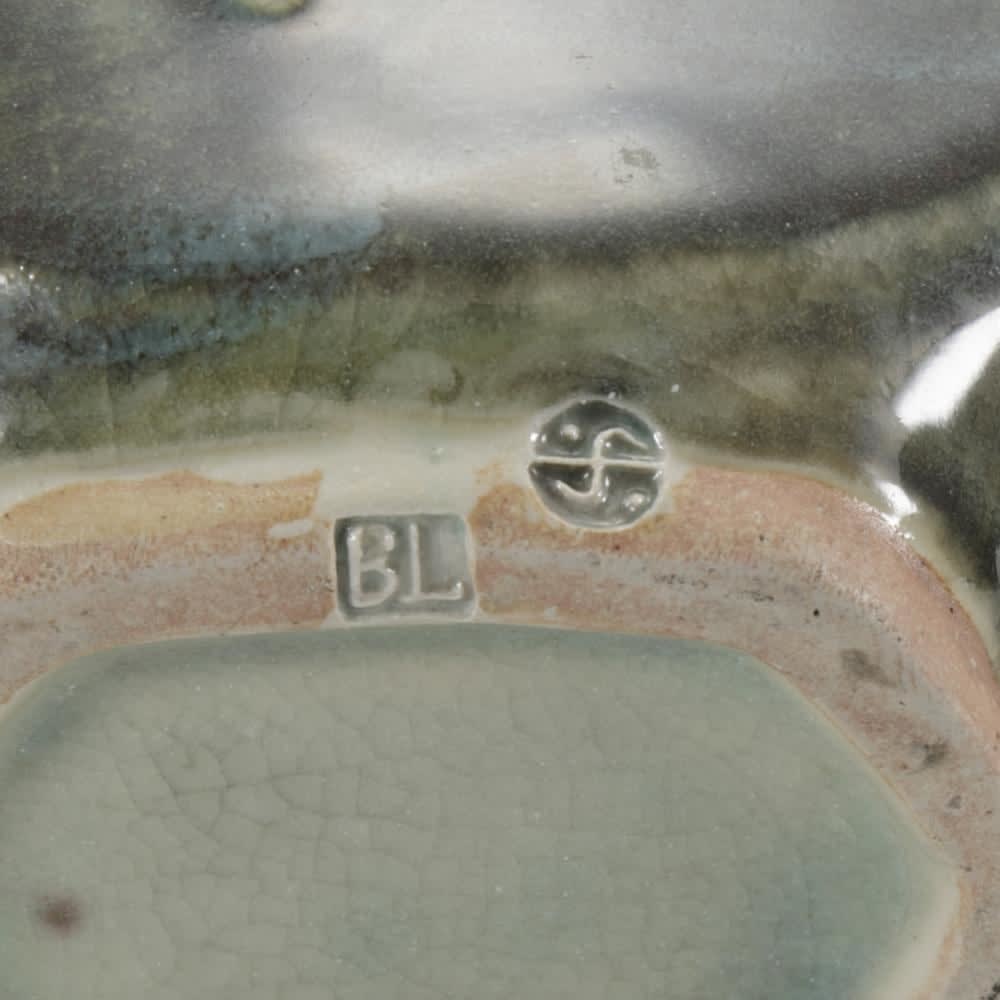Bernard Leach (1887−1979)
Vase
Sealed on foot
With a box signed by the artist (1963)
W15.5 x H20.5 cm
Further images
Slip trailing, a technique that pours or squeezes out the slips from tube to draw patterns, is employed on both sides of this impressive turquoise vase. “BL,” Bernard Leach’s own seal, and his kiln seal are impressed in the lower part of the body, very close to the base of the foot. Layers of glaze create the ever-changing glitter and hue.
Those facts such as the flatten shape without using the wheel throwing technique, the slip trailing patterns on the both sides, and the horizontal, square mouth resemble to the style of Kawai Kanjiro, who is, to Leach, as important as his lifelong friend Hamada Shoji. At first Yanagi Muneyoshi and Hamada, the two leading figures of Mingei (Japanese folk art movement), introduced to Japanese craftsmen their “discovery” of such a decorative technique in England. Contrasted to Kawai, Leach softened the ridge of the pattern, conveying the artist’s temperament as well as imparting an atmosphere of Western ornamental letters.
The encounter of Leach and Kawai could be dated back to the late Meiji period. Until 1963, the year signed on the box, their friendship had been lasting over fifty years. The influence and impetus between Leach and Kawai, who represented England and Japan respectively, ceaselessly evolving the craft art in their homelands, could be seen in this work. The present work also manifested the world of Bernard Leach, who was praised as a bridge between West and East.
Bernard Leach (potter; 1887−1979)
Hong Kong-born British potter. A former painter. Inspired by Japan’s folk crafts’ aesthetics and learnt pottery-making afterwards. Active in the Mingei Movement. Close to Yanagi Muneyoshi, Tomimoto Kenkichi, and Hamada Shoji throughout his life. His restrained and graceful style left great influence to modern Japanese crafts-making.
Those facts such as the flatten shape without using the wheel throwing technique, the slip trailing patterns on the both sides, and the horizontal, square mouth resemble to the style of Kawai Kanjiro, who is, to Leach, as important as his lifelong friend Hamada Shoji. At first Yanagi Muneyoshi and Hamada, the two leading figures of Mingei (Japanese folk art movement), introduced to Japanese craftsmen their “discovery” of such a decorative technique in England. Contrasted to Kawai, Leach softened the ridge of the pattern, conveying the artist’s temperament as well as imparting an atmosphere of Western ornamental letters.
The encounter of Leach and Kawai could be dated back to the late Meiji period. Until 1963, the year signed on the box, their friendship had been lasting over fifty years. The influence and impetus between Leach and Kawai, who represented England and Japan respectively, ceaselessly evolving the craft art in their homelands, could be seen in this work. The present work also manifested the world of Bernard Leach, who was praised as a bridge between West and East.
Bernard Leach (potter; 1887−1979)
Hong Kong-born British potter. A former painter. Inspired by Japan’s folk crafts’ aesthetics and learnt pottery-making afterwards. Active in the Mingei Movement. Close to Yanagi Muneyoshi, Tomimoto Kenkichi, and Hamada Shoji throughout his life. His restrained and graceful style left great influence to modern Japanese crafts-making.







